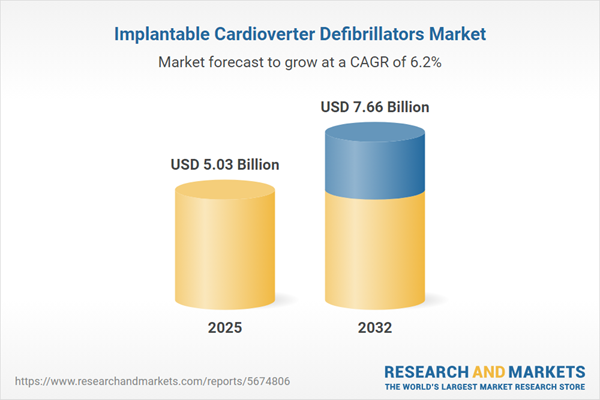Speak directly to the analyst to clarify any post sales queries you may have.
The implantable cardioverter defibrillators market is evolving rapidly, shaped by continuous advancements in device design, digital integration, and new procurement models. Senior leadership teams require trusted, actionable insights to effectively steer organizational strategy in this complex healthcare technology sector.
Market Snapshot: Implantable Cardioverter Defibrillators Market Size, Growth, and Outlook
The global implantable cardioverter defibrillators market is projected to grow from USD 4.73 billion in 2024 to USD 5.03 billion in 2025, reaching an estimated USD 7.66 billion by 2032, at a compound annual growth rate (CAGR) of 6.19%. This growth reflects steady momentum driven by advances in device engineering, improved cardiac monitoring features, and increased device miniaturization. Adoption is expanding in established and emerging healthcare environments, enabling broader access and supporting efficient cardiac care pathways. These trends also facilitate workflow optimization, addressing the needs of a growing cardiac patient base while integrating seamlessly into provider settings.
Scope & Segmentation of the Implantable Cardioverter Defibrillators Market
This executive report helps senior leaders uncover market opportunities, manage exposures, and guide critical procurement decisions across major categories:
- Product Types: Subcutaneous devices offer minimally invasive options for diverse patient populations. Transvenous products address chronic arrhythmia management, while wearable defibrillators extend cardiac oversight beyond traditional facilities.
- Indications: Devices for primary prevention serve higher-risk populations by lowering the incidence of acute cardiac events. Secondary prevention devices focus on supporting patients previously diagnosed with cardiac conditions requiring ongoing management.
- Technologies: MRI-compatible options preserve imaging access post-implant. Integration of remote monitoring solutions delivers continuous patient assessment, accelerating clinical responses and supporting digital health strategies.
- End Users: Diverse deployment environments include ambulatory surgical centers, specialty hospitals, cardiac care units, and outpatient clinics, each demanding customized clinical workflows and technology integration pathways.
- Regions: The Americas benefit from developed clinical infrastructure and sustained investment in cardiac devices. EMEA reflects diverse regulatory conditions and care models, while Asia-Pacific is advancing adoption and embracing innovative cardiac treatment protocols.
- Companies: Leading organizations such as Medtronic plc, Boston Scientific Corporation, Abbott Laboratories, BIOTRONIK SE & Co. KG, MicroPort Scientific Corporation, LivaNova PLC, Lepu Medical Technology Co., Ltd., Stryker Corporation, ZOLL Medical Corporation, and Kestra Medical Technologies Inc. focus on research, alliances, and clinical collaborations to strengthen portfolios and maintain market position.
Key Takeaways for Senior Decision-Makers
- Device innovation is enhancing real-time monitoring, helping providers streamline care delivery in high-demand cardiac settings.
- Accelerated clinical trials and broader studies are facilitating adoption in new markets, expanding access for underserved regions.
- Proactive diversification of supply chains and local manufacturing is boosting resilience to shifting regulatory and logistical conditions.
- Integrating implantable cardioverter defibrillators within health IT infrastructures allows for unified management and efficient data-driven decisions across multi-site care networks.
- Customizing device applications for varied clinical contexts supports consistent care quality and ensures policies align across decentralized organizations.
- Collaboration between technology partners and academic research accelerates device pipeline development and aligns innovation with new therapeutic standards.
Tariff Impact: Strategic Responses to U.S. Policy Shifts
Recent U.S. tariff changes have introduced added complexity to the overall supply chain in the implantable cardioverter defibrillators market. Leading firms are responding by scaling up domestic manufacturing, reinforcing supplier relationships, and advancing inventory tracking technologies. These strategies are designed to ensure stable product availability and continuity of care for patients amid ongoing policy and trade adjustments.
Methodology & Data Sources
This report synthesizes inputs from expert interviews with electrophysiologists, biomedical engineers, and healthcare leaders and is supported by onsite observations at key cardiac centers. Analysis further draws on regulatory records, peer-reviewed literature, supplier feedback, and recent findings from major industry conferences, ensuring well-rounded, authoritative market intelligence.
Why This Report Matters
- Empowers senior executives to craft focused investment strategies, streamline organizational portfolios, and respond with agility to regulatory and technology shifts.
- Enables identification and mitigation of emerging risks while leveraging new opportunities in dynamic cardiac device markets.
- Facilitates digital transformation and robust supply chain management to improve cardiac care quality and operational outcomes.
Conclusion
This analysis equips senior leadership with strategic clarity and evidence-based guidance for fostering innovation, strengthening resilience, and capturing growth within the evolving implantable cardioverter defibrillators landscape.
Additional Product Information:
- Purchase of this report includes 1 year online access with quarterly updates.
- This report can be updated on request. Please contact our Customer Experience team using the Ask a Question widget on our website.
Table of Contents
3. Executive Summary
4. Market Overview
7. Cumulative Impact of Artificial Intelligence 2025
Companies Mentioned
The companies profiled in this Implantable Cardioverter Defibrillators market report include:- Medtronic plc
- Boston Scientific Corporation
- Abbott Laboratories
- BIOTRONIK SE & Co. KG
- MicroPort Scientific Corporation
- LivaNova PLC
- Lepu Medical Technology Co., Ltd.
- Stryker Corporation
- ZOLL Medical Corporation
- Kestra Medical Technologies Inc.
Table Information
| Report Attribute | Details |
|---|---|
| No. of Pages | 194 |
| Published | October 2025 |
| Forecast Period | 2025 - 2032 |
| Estimated Market Value ( USD | $ 5.03 Billion |
| Forecasted Market Value ( USD | $ 7.66 Billion |
| Compound Annual Growth Rate | 6.1% |
| Regions Covered | Global |
| No. of Companies Mentioned | 11 |









